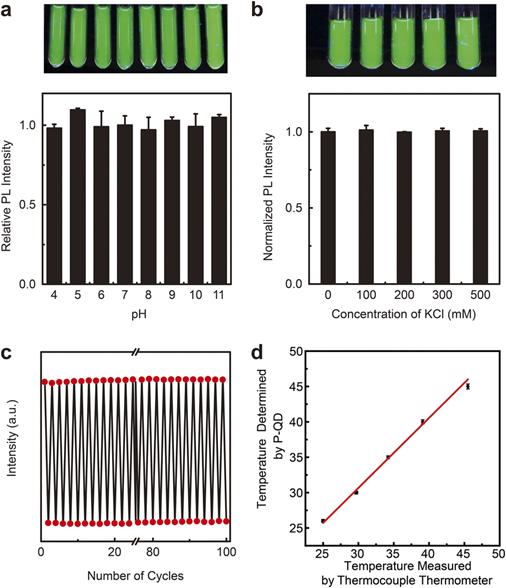Cells are the fundamental unit of structure and function in all living organisms. Different kinds of biochemical reactions or physiological processes inside the cell are closely related to temperature. Accurate intracellular temperature sensing is of fundamental importance not only for deepening the understanding of complex cellular metabolic activities, but also for its potential clinic application. In general, cells in the micrometer scale. And thus, to take the temperature of a cell, a thermometers with tiny size is needed. Recently, researchers from Institute of Genetics and Developmental Biology, Chinese Academy of Sciences (IGDB, CAS) and Peking University (PKU) have developed such a novel nanothermometer.
This novel nanothermometer is composed by CdSeS quantum dots and polymer materials. And this novel nanothermometer can easily internalize into a cell because of its size of 30 nm, equivalent to 1/2500 of a hair. Intracellular temperature can be decoded by detecting the temperature-dependent optical properties from this novel nanothermometer.
The advantages of this novel nanothermometer are not only its high detection sensitivity, but also its excellent biocompatibility. And more important is its nonsensitivity to complex cellular biochemical environment, such as pH and ionic strength. A fundamental fact is that the pH and ionic strength within a live cell are highly varying, and the emitting materials change their optical properties depending on these environments. And thus, these biochemical factors are difficult to be delineated from the thermal effect and thus the accuracy and reliability of the determined intracellular temperature are directly affected.
Recently, they developed a novel polymer-encapsulated QDs (P-QD), characterized by encapsulation of QDs in the matrix material of poly(methyl methacrylate-co-methacrylic acid) (PMMA-co-MAA). Interestingly, they found that P-QD exhibited strong resistance against physiological pH and ionic strength. Based on previous study, a luminescence nanothermometer has been developed and the prepared nanothermometer exhibits a linear response of PL intensity, with a high sensitivity. Notably, these nanothermometers show ultra-high reversibility and non-sensitivity to pH and ionic strength. Intracellular temperature sensing with high accuracy and reliability, as well as direct measurement of thermogenesis in individual cells have been achieved with these P-QD as probes.
This novel nanothermometer is expected to be potentially applied in the fields of cancer diagnosis and treatment, single-cell drug screening, brain science and nano/microelectronic. This work has been submitted to Scientific Reports and accepted as a research article (Sci. Rep. 5, 14879; doi:10.1038/srep14879). National patent has also been applied based on this work.
This work was partially supported by the grants from the National Natural Science Foundation of China and the Chinese Academy of Sciences.
Contact:
Dr. JIANG Yuqiang
Institute of Genetics and Developmental Biology, Chinese Academy of Sciences, Beijing
Email: yqjiang@genetics.ac.cn
Figure (a) Top: Photograph of P-QD in solutions with various pH, under 365?nm light. Bottom: The PL intensity as a function of pH. Error bars represent standard deviations obtained from three parallel experiments. (b) Top: Photograph of P-QD in solutions with different KCl, under 365?nm light. Bottom: The PL intensity as a function of the concentration of KCl. Error bars represent standard deviations obtained from three parallel experiments. (c) The PL intensity of P-QD under 25?°C (top panel) and 37?°C (bottom panel). The heating-cooling cycles were repeated 100 times. (d) The temperature determined by P-QD temperature probes and the values measured with a thermocouple thermometer. Error bars represent standard deviations obtained from three parallel experiments. (Image by IGDB)
 Figure (a) Top: Photograph of P-QD in solutions with various pH, under 365?nm light. Bottom: The PL intensity as a function of pH. Error bars represent standard deviations obtained from three parallel experiments. (b) Top: Photograph of P-QD in solutions with different KCl, under 365?nm light. Bottom: The PL intensity as a function of the concentration of KCl. Error bars represent standard deviations obtained from three parallel experiments. (c) The PL intensity of P-QD under 25?°C (top panel) and 37?°C (bottom panel). The heating-cooling cycles were repeated 100 times. (d) The temperature determined by P-QD temperature probes and the values measured with a thermocouple thermometer. Error bars represent standard deviations obtained from three parallel experiments. (Image by IGDB)
Figure (a) Top: Photograph of P-QD in solutions with various pH, under 365?nm light. Bottom: The PL intensity as a function of pH. Error bars represent standard deviations obtained from three parallel experiments. (b) Top: Photograph of P-QD in solutions with different KCl, under 365?nm light. Bottom: The PL intensity as a function of the concentration of KCl. Error bars represent standard deviations obtained from three parallel experiments. (c) The PL intensity of P-QD under 25?°C (top panel) and 37?°C (bottom panel). The heating-cooling cycles were repeated 100 times. (d) The temperature determined by P-QD temperature probes and the values measured with a thermocouple thermometer. Error bars represent standard deviations obtained from three parallel experiments. (Image by IGDB) CAS
CAS
 中文
中文




.png)
